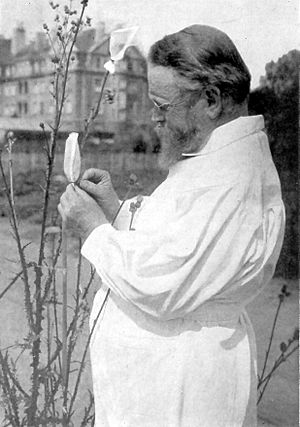Carl Correns facts for kids
Quick facts for kids
Carl Correns
|
|
|---|---|

Carl Correns in the 1910s
|
|
| Born | 19 September 1864 Munich, Kingdom of Bavaria
|
| Died | 14 February 1933 (aged 68) Berlin, Germany
|
| Scientific career | |
| Institutions | Kaiser Wilhelm Institute for Biology |
Carl Erich Correns (born September 19, 1864 – died February 14, 1933) was a German botanist (someone who studies plants) and geneticist (someone who studies how traits are passed down). He is famous for figuring out the rules of heredity (how characteristics are inherited) at the same time as another scientist, Hugo de Vries. Correns also made sure to give credit to Gregor Mendel for his earlier work on the same topic.
Correns was a student of Karl Nägeli, a well-known botanist. Mendel had actually written to Nägeli about his own experiments with peas.
Contents
Early Life and Education
Carl Correns was born in Munich, Germany, in September 1864. He became an orphan when he was young and was raised by his aunt in Switzerland.
In 1885, he started studying at the University of Munich. There, Carl Nägeli encouraged him to study botany. After finishing his studies, Correns became a teacher at the University of Tübingen. Later, in 1913, he became the first director of the new Kaiser Wilhelm Institute for Biology in Berlin-Dahlem. He married Elisabeth Widmer, who was a niece of Karl Nägeli.
Key Discoveries in Genetics
Carl Correns did a lot of important work for the field of genetics around the year 1900. He rediscovered and confirmed the findings of Gregor Mendel using different plants. He also found out about something called cytoplasmic inheritance. This was a big new idea that showed some traits are passed down in ways that Mendel's rules didn't fully explain.
Sadly, some of his notes and most of his lab books were lost during the bombings in Berlin in 1945.
Rediscovering Mendel's Laws
In 1892, while at the University of Tübingen, Correns started doing experiments on how traits are passed down in plants.
On January 25, 1900, Correns published his first paper. In it, he mentioned both Charles Darwin and Mendel. He showed how important Mendel's ideas were for understanding genetics. In his paper, Correns explained Mendel's results as the 'law of segregation' and introduced a new 'law of independent assortment'.
- Law of Segregation: This law says that each parent has two copies of a gene for a trait, but they only pass on one copy to their child. The child gets one copy from each parent.
- Law of Independent Assortment: This law explains that different traits (like plant height and flower color) are passed down independently of each other. Getting one trait doesn't affect whether you get another.
Cytoplasmic Inheritance
After rediscovering Mendel's laws, Correns did more experiments. He worked with the four o'clock plant, called Mirabilis jalapa. He wanted to understand why some traits, like the plant's green and white mottled (mixed) leaf color, didn't seem to follow Mendel's rules perfectly.
Correns found that while most traits follow Mendel's rules no matter which parent they come from, leaf color was different. It depended a lot on the mother plant.
For example:
- If he used pollen from a white part of a plant on a white flower (ovule), the new plants were all white.
- If he used pollen from a green part on a green flower, the new plants were all green.
- But here's the interesting part: If he used green pollen on a white flower, the new plants were white.
- However, if he switched them – white pollen on a green flower – the new plants were green!
This showed that the mother plant had a special role in passing on leaf color. This type of inheritance is called non-mendelian inheritance.
Scientists later found that this pattern was due to tiny parts inside the plant cells called chloroplasts. Chloroplasts are like tiny factories that make food for the plant and they are usually passed down only from the mother. If the mother's chloroplasts are not working correctly, the baby plant will get those non-working chloroplasts and will be white, even if the father plant could have given it "working" genes.
In his 1909 paper, Correns showed that variegated leaf color was the first clear example of cytoplasmic inheritance. This means that some traits are passed down through parts of the cell outside of the main nucleus (where most genes are).
His son Carl Wilhelm Correns became a geologist, and his second son Erich Correns (chemist) became a chemist. His daughter, Anna-Eva Correns, became a medical doctor.
See also
 In Spanish: Carl Correns para niños
In Spanish: Carl Correns para niños


